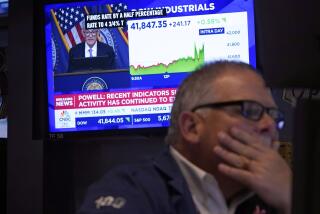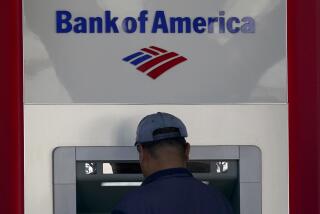B of A Trims Its Prime Lending Rate to 9.5% : Economy: Itâs the second big bank to do so. Others will probably feel pressure to follow suit, economists say.
Bank of America said Monday that it will cut its prime lending rate to 9.5% from 10%, a move that could increase pressure for other big banks to follow suit.
The action, which will take effect Wednesday, makes Bank of America only the second major bank to lower its prime below 10% since the Federal Reserve Board began pushing other interest rates lower several weeks ago in response to the weak U.S. economy.
Officials of the San Francisco-based bank provided little explanation for the move, announcing the rate cut in a one-sentence news release. âAny time you make a decision like this, you look at a number of criteria,â said Jim Mitchell, a Bank of America spokesman.
A cut in the prime rate has practical and symbolic meaning. The prime is widely watched by consumers and business executives, because banks peg a variety of adjustable-rate loans to it, such as home equity loans.
Most banks have resisted cutting their prime rates in recent weeks for several reasons, including the wish to keep profits up at a time of widespread financial fragility.
Banks also had been reluctant to attract more lending in the final days of 1990, because they wanted their year-end financial reports to look as solid as possible.
No major banks followed, for example, when First National Bank of Chicago dropped its prime rate to 9.5% almost two weeks ago. But the dawn of a new calendar year eases some of the pressure against expanded loan activity, and influential âmoney centerâ banks in New York--such as Citibank and Chase Manhattan--may feel pressure to follow Bank of Americaâs lead, economists said.
âIâll be surprised if we donât see downward pressure on rates Wednesday,â said Jerry Jordan, chief economist at First Interstate Bancorp in Los Angeles, referring to interest rates generally.
If major money center banks follow Bank of America in lowering the prime, he predicted, âWe and Security Pacific and Wells Fargo would follow along.â
The Fed last month added to rate-cut pressures when it lowered its discount rate--the rate that banks must pay to borrow from the Fed--to 6.5% from 7%. Fed officials also relaxed reserve requirements for banks, seeking to boost bank profits.
While government policy-makers would like to see lower interest rates and increased lending by banks to jog the slumping U.S. economy, bank executives have been unusually cautious in recent months. More loans would weaken what banks call their capital ratios--a key measure of bank health--and would have shown up on their year-end reports at a time of heightened worries about bank stability.
Bank of America, however, has a healthier capital ratio than many of its competitors, Mitchell said. The timing of the rate cut was not dictated by year-end financial considerations, he suggested.
Other banks, meanwhile, gave little sign Monday that they were about to cut their prime rates, despite predictions that there may be a flurry of such moves soon.
âWeâve made no announcement that weâve moved the prime,â said Deborah K. Lewis, a spokeswoman at Security Pacific National Bank in Los Angeles.
More to Read
Inside the business of entertainment
The Wide Shot brings you news, analysis and insights on everything from streaming wars to production â and what it all means for the future.
You may occasionally receive promotional content from the Los Angeles Times.










